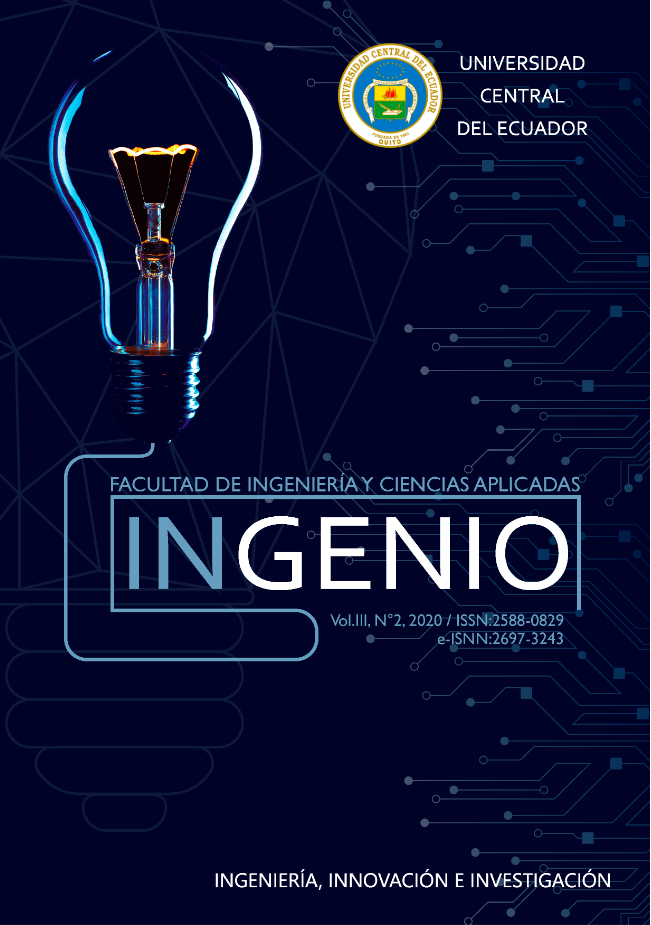Español
Main Article Content
Abstract
The purpose of this paper is show complete, accurate and real-time information about the mobility of users on a campus, identifying types of users and their characteristics, all through a computer platform consisting of two applications, an API specialized in storage from the purified data to a relational database, and a web application that presents information to the user. This platform is developed through the use of open source technologies and tools. The information provided comes from the Access Points installed in the campus communication network, which, through computer processing, is anonymized, stored, purified and classified for later analysis. As a case study, the application has been implemented in the university context specifically at the Central University of Ecuador.
Downloads
Metrics
Article Details

This work is licensed under a Creative Commons Attribution-NonCommercial-NoDerivatives 4.0 International License.
References
J. Ortuzar and L. Willumsen, “Modelling Transport” 4th Edition, Wiley, Hoboken, John Wiley & Sons, 2011.
M. Picornell, “Metodología para la extracción de patrones de movilidad urbana mediante el análisis de registros de actividad telefónica” PhD. Tesis Doctoral, Escuela de Doctorado, Universidad Politécnica de Valencia, Valencia, España, 2017.
D. Orellana, “Métodos para el análisis de patrones de movilidad no motorizada”, Universidad de Cuenca, Cuenca, Ecuador, 2016.
DTIC. (2020). Indicadores Open Data UCE [En línea]. Disponible en: https://datosabiertos.uce.edu.ec/Indicadores
D. Hallo, “Desarrollo de una Aplicación para la gestión del Mercado Inmobiliario en la ciudad de Quito utilizando la plataforma iPhone”, Tesis, Universidad Politécnica Nacional del Ecuador, Quito, Ecuador, 2014.
L. Gonçalves. (2019, enero 25). Qué Es La Metodología Ágil. [En línea]. Disponible en: https://luis-goncalves.com/es/que-es-la- metodologia-agil/
Oracle. (2014, agosto 8). ¿Qué es la tecnología Java y para qué la necesito? [En línea]. Disponible en: https://www.java.com/es/download/faq/whatis_j ava.xml
M. Alvarez. (2019, octubre 23). Qué es Java [En línea]. Disponible en: https://desarrolloweb.com/articulos/497.php
Á. Robledano. (2019, agosto 12). Qué es Java: Principios básicos y evolución [En línea]. Disponible en: https://openwebinars.net/blog/que-es-java/
A. Guevara. (2016, agosto 26). ¿Qué es Java y por qué aprenderlo? [En línea]. Disponible en: https://devcode.la/blog/que-es-java/
J. Gil. (2018, diciembre 16). Qué es PostgreSQL [En línea]. Disponible en: https://openwebinars.net/blog/que-es-postgresql/
PostgreSQL. (2012, noviembre 12). POSTGRESQL [En línea]. Disponible en: http://postgresql- dbms.blogspot.com/2012/11/blog-post.html
C. Dorantes. (2015). Qué es PostgreSQL y cuáles son sus ventajas. [En línea]. Disponible en: https://platzi.com/blog/que-es-postgresql/
Hopla Software. (2018). Ventajas de PostgreSQL. [En línea]. Disponible en: https://hoplasoftware.com/201612ventajas-de- postgresql/
QGIS. (2016). QGIS - El SIG Líder de Código Abierto para Escritorio. [En línea].
Disponible en: https://qgis.org/es/site/about/index.html
Esri Chile. (2019, mayo 9). ¿Qué es GIS? [En línea]. Disponible en: https://www.esri.cl/es- cl/que-es-el-gis/que-es-gis
M. Musse. (2017, mayo 20). ¿POR QUÉ ELEGIR QGIS? [En línea]. Disponible en: http://www.edutig.org/por-que-elegir-qgis/
DESDELINUX. (2015). QGIS: Software libre para sistemas de información geográfica [En línea]. Disponible en: https://blog.desdelinux.net/qgis-software-libre- para-sistemas-de-informacion-geografica/
S. Pérez. (2019, julio 22). ¿Por qué software libre? Ejemplos de aplicación de QGIS en el ámbito de la gestión de recursos hídricos [En línea]. Disponible en: http://www.comunidadism.es/blogs/%C2%BFpo r-que-software-libre-ejemplos-de-aplicacion-de- qgis-en-el-ambito-de-la-gestion-de-recursos- hidricos

